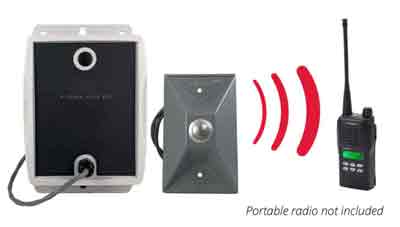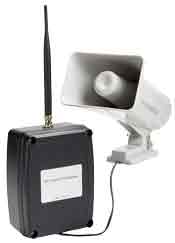 The purpose of a commercial wireless doorbell is to alert your staff of people at a door. They are often used for front-of-store early entry, back-of-store delivery areas (delivery door/loading dock), health screening entry, or other controlled entry points. They increase productivity by enabling staff to remain busy rather than waiting at doors.
The purpose of a commercial wireless doorbell is to alert your staff of people at a door. They are often used for front-of-store early entry, back-of-store delivery areas (delivery door/loading dock), health screening entry, or other controlled entry points. They increase productivity by enabling staff to remain busy rather than waiting at doors.There are several differences between a commercial wireless doorbell system and one for designed for residential use. They are detailed here:
- Quality: There are lots of cheap options on the market that aren’t designed for the heavier use in a commercial or industrial environment. The build quality of an industrial wireless doorbell is much higher, therefore they will last longer under more abusive use.
- Range: Most wireless doorbells are designed for stick-and-drywall-built homes so they don’t have to penetrate the more challenging obstacles in a commercial environment. They also don’t have as large of a coverage area since houses are generally smaller. Commercial wireless systems have higher wattage and they use business-band radio frequencies so they can cover a larger area. Also, the transmitter can be mounted inside the building which eliminates the wall of the building as an interference source. Typical range can be a 1/4 mile or 50,000 square foot of coverage.
- Flexibility: You have more choices in what you use to receive the wireless signal from the doorbell. With these industrial buzzer systems, the signal comes in via 2-way radio devices. You can get either handheld units for staff that needs to be mobile, or base station intercoms that sit on a desktop. You can even use existing two-way radios you have so you don’t need to buy anything new for this half of the system. This lets you design a system that works for you instead of just having to use a device that comes with the doorbell system.
 Features: Residential systems just sound a door bell tone on a receiver. A commercial door bell system sends a customized voice message alerting in-store employees over their two-way radios. You can record messages like “Delivery door 1” or “Staff needs entry” so you know exactly which door you need to go to. No need to train people what different tones mean. You can also program an “escalate” message to contact alternate radio users if the first message doesn’t draw staff to the door. This lets managers or other staff no that no one is going to the door.
Features: Residential systems just sound a door bell tone on a receiver. A commercial door bell system sends a customized voice message alerting in-store employees over their two-way radios. You can record messages like “Delivery door 1” or “Staff needs entry” so you know exactly which door you need to go to. No need to train people what different tones mean. You can also program an “escalate” message to contact alternate radio users if the first message doesn’t draw staff to the door. This lets managers or other staff no that no one is going to the door.- Accessories: So what if your staff is mobile but you don’t want them to carry a radio? You can use a wireless public address (PA) receiver to broadcast messages so everyone hears the message. These 2-way radio receivers will broadcast the message over amplified horn speakers so they can be used in even the noisiest environments.
So you see that commercial wireless doorbell systems offer much more capability and flexibility than using a standard wireless doorbell. To see these systems just look below.